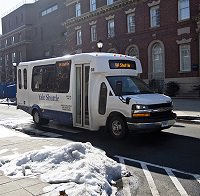
As the buildings around campus test experimental ways to employ a Carbon Charge, Yale’s fleet is also stepping its game up to help the university reach its greenhouse gas emissions reduction goal. Three of its cutaway buses have been upfitted with hybrid motors, leading to significant fuel savings, bringing us closer to our goal of reducing carbon emissions to 43% below 2005 levels by 2020.
Two of Yale’s largest buses, like those on the blue line, run on compressed natural gas (CNG). As a fuel, natural gas burns more cleanly than gasoline or diesel. The vehicles were also switched over when gas was nearly $4 a gallon. At the time, switching to CNG brought two clear advantages – a reduction in price, and a drop in greenhouse gas emissions.
For a time, it seemed natural that efficiency upgrades to the cutaway buses should change the motors to CNG, as well. However, with recent drops in gas prices, the fleet began to consider other, newer green options to hit its emission reduction goals.
Though natural gas is touted as a cleaner fuel than diesel or gasoline, hybrid engines reduce the total amount of fuel used, leading to fewer emissions per mile traveled. “[CNG] moves the fossil fuel usage, while [hybrids] reduce the fossil fuel,” explained Ed Bebyn, Director of Parking and Transit.
Since Yale’s vendor for the cutaway buses doesn’t offer hybrid models, the fleet contracted with a third party to install the motors in new buses. They were quickly demonstrated to be a success, showing a 20-25% decrease in fuel use per vehicle. Over time, the fleet hopes to upgrade all of its cutaways from gas and diesel motors to hybrids.
Switching away from CNG has operational benefits, as well. Since CNG is less common than gas and diesel, CNG vehicles are obligated to drive to a single station in New Haven where they can refuel. Combined with the fact that fuel tank readings on CNG vehicles are less reliable, this lack of accessibility represented a real liability, which is avoided by using gasoline-electric hybrids. Vehicle operators don’t need to worry about running out of fuel and getting stranded because gas is easy to find. The widespread use of hybrid vehicles also makes it easier to find technicians who can operate on the cutaways, which is another quality of life perk.
“All this stuff is new technology. Somewhere, large players like [Yale] need take the lead,” said Ed Bebyn. Six more hybrid cutaways have been ordered, and will be arriving soon. The switch is paying off, and making transit go from green to greener.